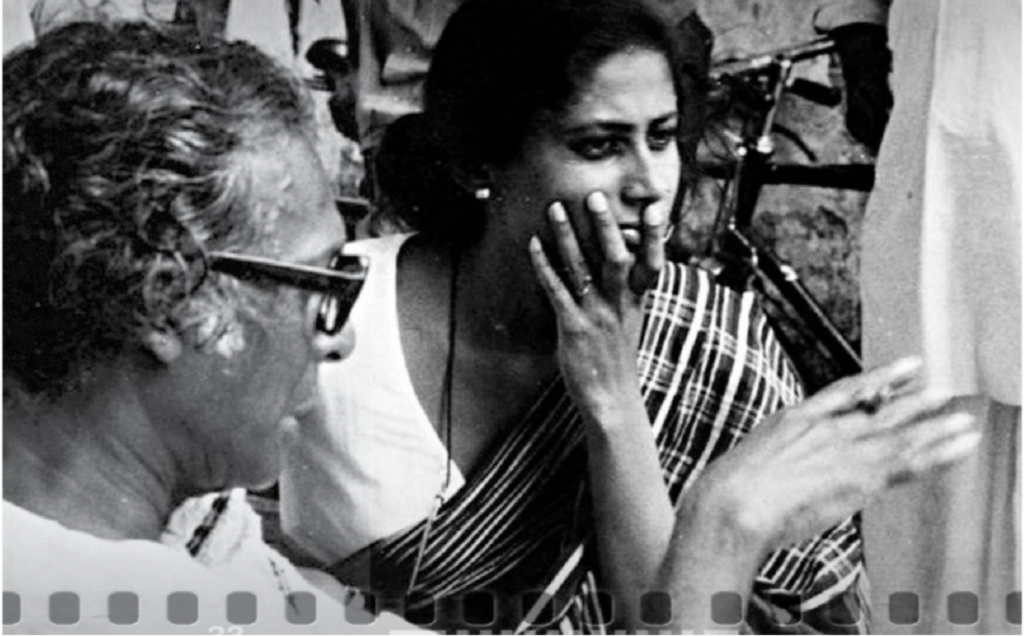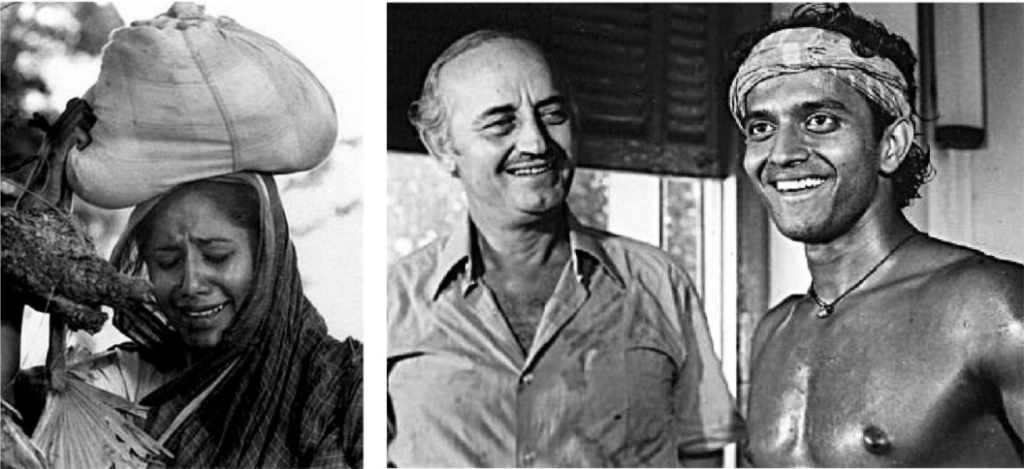In Mrinal Sen, world cinema lost a towering animator of the celluloid with his clear Leftist humanism and his political commitment to the common man, the ‘Last of the Mohicans’ of Indian cinema, Satyajit Ray, Ritwik Ghatak, and him
By Prasanta Paul
IF you look at it as our way, let us say, on the sets of a film being shot between Bengal and Odisha in 1975, it was like this:
SCENE 1, Shot 1: Director of a film, Mrigayaa (The Royal Hunt) taps the debutante actress and says: “In the film, you are a tribal girl. But you are too fair for that. So for the next few days, go around in the sun and get a dark tan.” She consents, of course…
SCENE 1, Shot 2: The director stops on his path and tells the girl, then all of 20: “By the way, in your first shot, you will have to do a rape scene.”
Having said that, the director walks away, leaving the girl worried sick… how many would attack her? How would she defend herself? Her mother, who was on the sets, would be of little help, so then?
She – and now let us bring to you the ethereally beautiful Mamata Shankar as the debutante actress – was left for the next few days in a long nightmare.

That is the realism of Mrinal Sen, to capture from the ground and put every particle of reality into his films
Finally came the call for her first shot: The director’s expected call: “Lights… camera… rolling… ACTION.”
At the end of the shot, Mamata was askance: Is the shot over? But she had been told that there would be a rape scene… By this time, the pretty woman had become gaunt and emaciated.
“Is the shot over?” she asked Mrinal Sen, the director.
“Ah, yes, you can go and relax.”
“Yes, but you had told me there would be rape…”
CHARACTER CREATION
The bespectacled Sen, attired in his typical Bengali dhuti-panjabi (dhoti-kurta), laughed aloud: “Oh, that! There was never going to be a rape, but if I did not put that into your mind, I would never get that hunted look in your eyes. Now go and relax.”
MRIGAYAA, THE ROYAL HUNT
They say that a film is as good as the director can get it out of the actors. This is how Sen got it out of – in this one instance – Mamata Shankar. Of course, he would again bring her back to his cast in the remarkable film against patriarchy, Ek Din Pratidin, where Mamata is largely unseen on screen, but holds a massive question mark over the heads of her family and neighbours, who start questioning her ‘character’ simply because she – whose job feeds the impoverished family living in an old Calcutta labyrinth is very late in returning home.
This was the 1950s and 60s. Sen, it must be remembered, was making films alongside two global film Goliaths: Satyajit Ray and Ritwik Ghatak. Ray came from the aristocratic family of Upendrakishore Ray Chowdhury. And though the end-image of Ghatak was one of a
doddering drunkard (perhaps something he chose to wear), he too came from a family whose home Rabindranath Tagore visited. Contrastingly, Sen was sure shot middle-class.
The other contrast was that while Ray stuck to his class background and made films centred purely around it, Ghatak, with his grounding in the steadfastly communist Indian People’s Theatre Association, declassed himself for films like Ajantrik, Meghe Dhaka Tara and then, after many others: Titash Ekti Nadir Naam.
In between, stood the third Eiffel Tower of film realism: Mrinal Sen.
AKALER SANDHANE
“Babura eyechen aakaal khungtey… aakaal to amader shobbangey!” (The sahibs have come looking for the famine… the famine is all over us) An emaciated old man comments wryly at the hectic preparations – lights, camera, food for the team, yes, food for the team, when the villagers are going hungry – for the shooting of Akaler Sandhane (In Search of Famine).
This is the realism of Sen, a Brechtian realistic critique of his own endeavours while shooting for a film in retrospect on the inhuman Bengal Famine of the 40s.
In between, as the film rolls on, a cycle rickshaw carries a loudly screeched message from a megaphone, asking people to come and see the film The Guns of Navarone. The announcement invites audiences to watch the iconic film of Anthony Quinn, and says: “Come and watch the most beautiful queen on earth!”
That is the realism of Sen, to capture from the ground and put every particle of reality into his films. This Brechtian courage is starkly missing in Ray, whose efforts are built solely around how artistically (to his mind and to those of his fans) he could narrate a story. Ray tried his hand at realism in the film Jana Aranya, for which he got roundly blasted.
Sen showed this realism very early in his film “Akash Kusum” (Daydreams). It is the story of the longings of a middle-class executive to rise in stature and greater social acceptability. The young man, still trying to find a place in the corporate world, puts up an innocent bluff to a young girl he chances upon. His deception increases till they become disastrous for him, and for their relationship.
This intense understanding of class realities outside the hue and cry of ‘revolution’ marks one of Sen’s finest sensibilities.
NO TO RoP
Sen flatly declined to see eye to eye with many of the conventional concepts the modern film making has been associated with – namely the market and RoP (Return on Product). Unlike some of his contemporaries and a large majority of modern filmmakers, the market and the return hardly impacted this out-of-the-box director, whose non-compromising attitude and stance earned him many a basher at home.
Fortunately though, the international acclaim his films had fetched, put those bashers at bay during his lifetime. It was his passion to continuously experiment with form and content that saw him producing a host of ‘reel legends’ like Bhuvan Shome, Ek Din Pratidin, Akash Kusum, Interview, Padatik, Akaler Sandhane, Ek Din Achanak and scores of others.
If Ek Din Pratidin is an indictment of patriarchy and deals with the middle-class social crisis and Kharij the social milieu, the famine of 1943 gets a different portrayal in Akaler Sandhane; the political and social unrest finds a voice in Interview, Calcutta 71 and Padatik. It was he who first initiated the new cinema movement in India.
Though Satyajit Ray has always hogged the limelight in terms of international exposure and adulation, Sen was no less. Half the world’s cine giants were on first name terms with him.
Not to extend a parallel too far, remember the French director Louis Malle? Once, Malle landed up in the city when the Left students’ movement was at its peak.
Sen took Malle in the midst of a gathering of nearly two lakh students at Shaheed Minar and then followed a commandment from Sen to Malle: “Take as many pictures as you want; you’ll relish them later.” Malle, in perfect awe of the moment, obliged Sen as much as he could. Calcutta, the city, with all its virtues and vices, had always inspired Sen.
CALCUTTA TRILOGY
Sen, Ray and Ghatak, all were conscious of the Naxalite movement, the basically student-driven ultra-Left revolutionary movement that started in north Bengal in 1967.
It is interesting to note that two trilogies were done during the entire epoch: The Apu Trilogy by Ray, where he went from poetic to poetic, romantic to romantic, on Bibhutibhushan’s novel of a village boy and his later life, untouched by the terrible reality of state terrorism that saw hundreds of talented youth being killed by the police in false encounters almost every day.

Sen dwelt upon that, and hence the massive masterpiece, Calcutta 71.
The first part of the trilogy is Interview about a job that had been promised to a young aspirant, but by the time he turns up, someone else had grabbed it. However, the ‘process’ had to be gone through, and the promised aspirant was suddenly asked: “What is the weight of the moon?” The bewildered young man looked around, and was asked once again: “What is the weight of the moon?”
This stark realism of miserable middle-class existence marks Sen’s works, al a Gabriel Garcia Marquez, and is again and again played out in films like “Ek Din Pratidin”.
BURNT SCREEN
The value of his contribution to the art of cinema is not just artistic but must be assessed in the light of his humanita-rianism embracing his warm compassion, especially for the meek, and his profound concern for social justice. He did not seek recourse to any sort of comfort zone (unlike many of his contemporaries) which is why each of his films speaks independently in a different nuance.

The endeavour to shed a new light that ‘was never there on earth, sea or land’ on each film (come what may!) has given Sen a signature that is rare in Indian cinema
He has continuously broken his own narrative structure and eked out an independent path for each of his films. Hence, the narrative we find in Chorus does not get repeated in Bhuvan Shome; or if Ek Din Pratidin weaves a new structure, Antareen treads an independent path.
The endeavour to shed a new light that ‘was never there on earth, sea or land’ in each film (come what may!) has given Sen a signature that is rare in Indian cinema. And obviously, he had eclipsed many an Indian director in his over-riding concern for the humanity.
It is just amazing that Sen did a scorching film, Oka Oori Katha.
In gist from Wikipedia is the narrative:
Venkaiah (Vasudeva Rao) and his son Kistaiah (Narayana Rao) live in a village. Venkaiah lives in a queer world of his own. They have learnt to conquer hunger and are mentally strong. They consider that the poor farmers are fools to work for the rich and suffer. Kistaiah wants to marry Nilamma (Mamata Shankar). The father does not like the marriage. Kistaiah marries Nilamma.
Nilamma tries to control the family. Venkaiah does not change. Kistaiah stands between them. There is bitterness in the family. In course of time, Nilamma conceives. One day, they find Nilamma in acute pain. The father refuses to call a midwife and Nilamma dies. They decide to conduct funeral rites for Nilamma. They go begging around the village and gather some money and decide to spend it on alcohols.
There is no cinematically stronger film in Indian film history than this. The depiction of the Telugu villagers, their dress, body language, almost vulgar utterances… and then the last scene when the two men get drunk on the money for the Kafan (Munshi Premchand’s heart-tearing story of that name)…
And then, as and when the audience is watching, the screen burns up… one would think an accident, but no, the shot shows the screen burn up. And then, the screen goes black.
It is a cinematic idiom that would take a literary Marquez ages to conjure up.
Unfortunately, with Sen now gone, the screen has gone black, for a while indeed!
